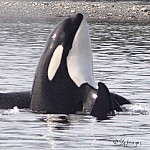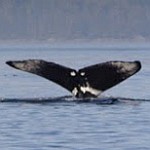Looking out over the quiet surface of the ocean is deceiving. One would think that life beneath the surface would also be peaceful, so far away from man-made noises. How wrong could we be?
Sound in water travels much faster and further than air – about five times faster in the sea because of the higher density of saltwater compared to air. In places where background noise levels have been recorded since the 1950’s, noise has increased by 3 decibels every 10 years. Underwater ocean noise is believed to have increased between eight and up to one hundred fold since the 1950’s, caused mainly by the dramatic increase in merchant ships travelling our oceans. Another source of significant ocean noises are related to the military’s use of large ships and of high-intensity, low-frequency underwater sounds. Military sonar, that can result in concussive injury and interference with the normal pattern of underwater acoustic communications of marine life and whales, can reach 235 decibels. Air guns used for oil and gas exploration and construction can produce sound up to 200 decibels. (As a comparison, rock concerts produce sounds of about 100 to 120 decibels which causes pain to human ears.) Recreational and tourist vessels also contribute to the increasing amount of underwater noise.
Low frequency sounds are known to travel further than high frequency sounds. Whales such as Humpback whales produce low frequency sounds in order to communicate with each other and find mates. These sounds can travel hundreds to thousands of miles underwater. However, much of the background noise caused by ships and even wind farms is low frequency sounds. This background noise is capable of masking sounds produced by whales, and therefore affects communication between individuals. Since sound is their main form of communication, noise interrupts critical life processes of whales and dolphins. Excess noise also impacts how successful they are at feeding as well as their ability to navigate and avoid stranding on shores. In short, noise is a stress on Cetaceans.
Dolphins also suffer from the impact of an increased noisy sea. In stranded dolphins, scientists have observed severe hearing loss in some of them and have determined that it is likely that some dolphins lost their hearing due to noise pollution. In British Columbia, a study demonstrated that Orca from three different pods all produced longer calls when surrounded by whale watching boats. Researchers have also observed that Orca increased their speed of travel or changed directions when surrounded by boats. Since Orca use echolocation or active listening in order to detect prey, it is likely that noise produced by boats interfered with their ability to detect prey which negatively impacted their ability to feed.
In the Broughton Archipelago, Alexandra Morton observed that acoustic harassment devices used to scare away seals on fish farms also impacted Orca behavior. Orca presence in the area, both Resident and Transient, decreased dramatically. When the use of those devices stopped in 1999, Orca returned to the area. In another study, similar results were observed with Harbour porpoise in the area when an acoustic device was used.
Worldwide, increased background noise has led researchers to observe whales producing louder calls and higher than normal frequency sounds as well as being less successful at catching prey.
What can you do?
- Decrease noise in the oceans by decreasing the speed of boats and vessels we travel in.
- When observing Cetaceans from a vessel, follow laws regarding speed and maintain a minimum distance of 100 meters. Limit your time with a whale or a group of Cetaceans to about 30 minutes. (If observing Southern Resident Orca, the minimum viewing distance is 400 meters.)
- Be aware of Cetaceans in the area you travel.


